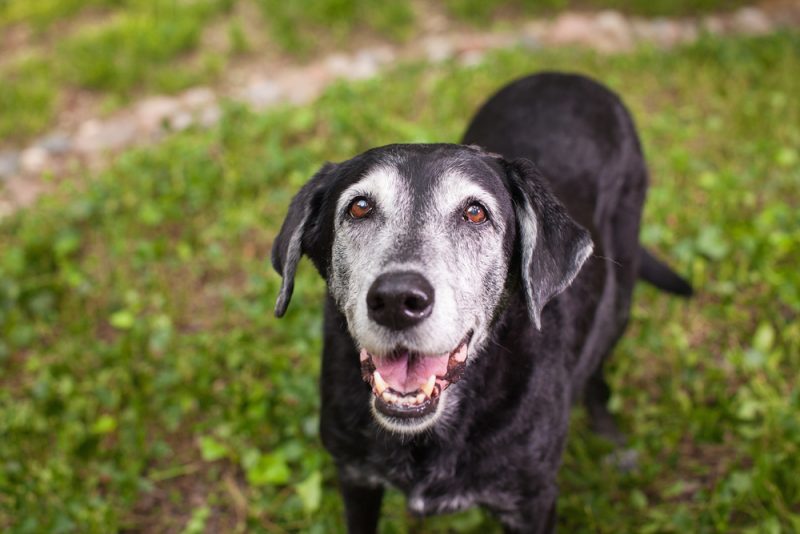
Many people think that a 1-year-old dog is equivalent to a 7-year-old human. That figure is an oversimplification and not quite accurate. Depending on the animal’s size and other variables, an 11-year-old dog would be roughly 60 to 86 years old, depending on things like breed and size. If that seems out of line, remember that our canine companions have much shorter lifespans than we do.
After all, the oldest dog on record is 31 years old.1 The same record for humans is over 117 years old and counting.2 Nevertheless, age is something we can relate to easily, making it a useful measurement. Perhaps it can help you understand why your 1-year-old dog acts like a teenager. That’s because they are!
| Size: | 11-Year-Old Dog’s Age in Human Years: |
| Small breed (<20 pounds or less) | 60 years |
| Medium breed (21 to 50 pounds) | 65 years |
| Large breed (51 to 100 pounds) | 72 years |
| Giant breed (100+ pounds) | 86 years |
Source: Almanac.com


How to Calculate Dog Years to Human Years
The 7-year calculation doesn’t work when you consider the facts. Depending on the breed, dogs are sexually mature at between 1 and 2 years old. That certainly doesn’t apply to humans. It’s also variable. We must also factor in the breed. Small breeds live much longer than large ones. One study concluded that the latter age quicker, thus accounting for the differences in lifespans.3
That means we can’t apply a simple formula to calculate dog years to human years without considering the animal’s size as part of the equation. Therefore, a linear relationship between canine and human age doesn’t exist. Instead, researchers at the University of California San Diego developed an algorithm that provides a more accurate assessment. It varies with the size of the dog because of its effect on their lifespan.


What’s the Science Behind Dog vs. Human Years?
We discussed the lifespan differences between small and large dogs. Scientists have quantified this difference as one less month of life expectancy for every 4.4 pounds of body mass.
There also seems to be an association with the over-expression of IGF-1, a growth hormone in large dogs relative to small dogs. Currently, research studies are looking into this in hopes of creating a new drug to expand dog longevity.4
Again, many things influence these conditions, including the animal’s DNA and its associated traits, as well as diet, habits, and other environmental factors that may trigger or suppress adverse events. Epigenetics is a new area of research that studies phenotype changes that do not involve the sequence of DNA nucleotides. Factors that affect gene expression and allow organisms with the same genetic sequence to look and behave very differently and how this affects their health and longevity. Many parameters exist without a direct human comparison that can affect a dog’s quality of life and, in turn, their lifespan. Separation anxiety and its ensuing stress immediately come to mind.
The other wild card involves inbreeding. People have selectively bred modern-day breeds of dogs for roughly the last 160 years. That has made some traits fixed in the animals’ DNA for good and bad. It may result in greater propensities for specific health conditions that can profoundly affect their lifespan. A dramatic example is the popularity of brachycephalic dog breeds, like French Bulldogs and Pugs.
Their short muzzles and large foreheads may make them look cute, but these features have severe health consequences, including an increased risk of heatstroke, exercise intolerance, and brachycephalic obstructive airway syndrome (BOAS). That further complicates equating dog and human years. It even calls into question the existing algorithms without taking into account the breed.
The obstacle to developing the science in this case, as it has many questions, lies with data. Scientists need sufficiently large sample sizes to make and test hypotheses and drill down to specific answers. Researchers have three primary sources for this information: veterinary hospitals, breed club surveys, and pet insurers. The latter only covers a mere fraction of the 83+ million dogs in the United States.
Therefore, we can only provide general conclusions but cannot give you information pertinent to certain breeds and individual dogs. Remember that these calculators also don’t account for the environmental factors that can affect a dog’s age and the corresponding figure in human years.


The Life Stages of a Dog
All dogs go through the same four life stages. The variability exists with the length of them and the other biological factors that can influence their spans. One-time life events, such as spaying or neutering, can also affect an animal’s life stages and lifespan. The American Animal Hospital Association (AAHA) recognizes four distinct stages with variations depending on breed, including the following:
- Puppy: Birth through growth
- Young adult: Physical maturity at between 6 to 24 months old
- Mature adult: Adult to within the last 25% of the animal’s lifespan
- Senior: Last 25% of the dog’s life
The question of desexing is also something to consider. Research has uncovered the pros and cons of the procedure that can directly affect the animal’s quality of life and lifespan.
They include an increased risk of joint disease and some cancers, with the prevalence varying with the breed. The takeaway is that assessing the human age of an 11-year-old dog is more nuanced than we may realize, especially if it brings in questions of disease and quality of life.
Life Span by Breed Size
| Size: | Average life span: |
| Small breed (<20 pounds or less): | 12–15 years |
| Medium breed (21 to 50 pounds): | 10–13 years |
| Large breed (51 to 100 pounds): | 8–12 years |
| Giant breed (100+ pounds): | 8–10 years |
Source: AKC


Key Factors That Affect the Dog’s Aging Process
A dog’s size is directly correlated to their lifespan, however, their genetics, diet, habits, and environment also play a very important role and affect their longevity.
A dog’s social life can directly affect aging and their lifespan. Pets that are socialized early in life are less fearful as adults. This trait often leads to aggression, which can, in turn, result in relinquishment because of undesirable behavioral issues. These facts underscore the importance of the owner’s responsibility to the welfare of their animal companions.
Many factors rest with the breeders. Health screenings are imperative to avoid passing on negative traits to the offspring. Most parent clubs have a litany of tests they recommend for the welfare of the animals. Individuals who participate in the Orthopedic Foundation for Animals (OFA) Canine Health Information Center (CHIC) program must fulfill specific requirements for certification.
DNA testing is another vital piece. Dogs may carry potentially harmful traits without visually presenting them. Nevertheless, they can pose health risks if the pups are bred with other carriers. The other uncomfortable variable is breeding dogs with seemingly desirable characteristics that can possibly shorten a dog’s lifespan because of health issues, such as brachycephalic breeds.
Recognizing the human’s role in the dog’s aging process is essential. It starts with responsible breeding but continues with providing a good quality of life. Giving your dog endless treats to the point of obesity doesn’t help a pet. It can lead to a cascade of adverse health issues. Other variables include training, socialization, and mental stimulation. All can influence how well your pooch ages.


Conclusion
We can speak of the human equivalent of an 11-year-old dog, but it has multiple influences. The adage of 7 years is woefully simplistic and fails to take into account the many factors affecting the number, including your pet’s quality of life. The latter is the most important thing. In the end, your pet deserves the best you can provide for the joy they bring to your life.
Featured Image Credit: S Bliault, Shutterstock




